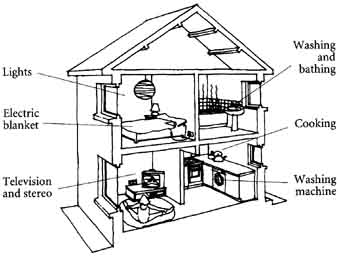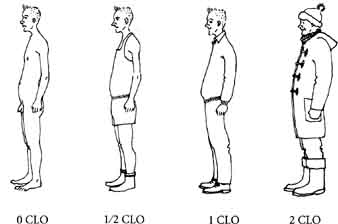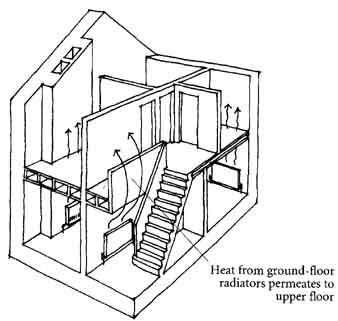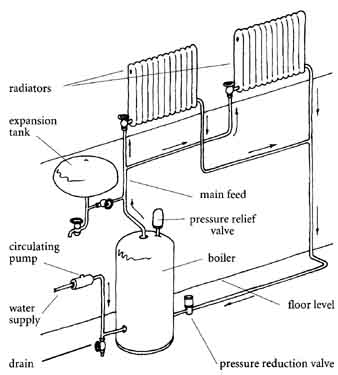Heating our homes, including the heating of hot water, accounts for the vast majority of energy that is used domestically, and represents one of the greatest wastes of energy that we at present indulge in. Many of us have outdated, oversized, and inefficient systems that are not making the best use of the energy delivered to them. After you have draft-proofed and insulated your home, you will almost certainly find that your heating appliance or appliances are oversized and , if you have done the job well, you will be able to save up to 75% of the energy expended previously on heating. This section looks at the factors that affect our heating systems and points towards ways of making the very most of the systems we have. These include:
Identifying the different sources of heat within our homes and how we can conserve them
• Choosing an appropriate way to update our systems Maximizing the potential of the total system
• Choosing and using controls effectively
• Maintaining the system for maximum efficiency

Other sources of heat inside the house: Lights;
Electric blanket; Television and stereo; Washing and bathing; Cooking;
Washing machine
CONSERVING THE HEAT WITHIN OUR HOMES
Our space-heating appliances are not the only sources of heat within our homes. Other sources of heat are:
• Lights
• Kitchen stoves
• Hot water
• Refrigerators
• Color televisions
• Washing machines
• Dishwashers
• Clothes dryers
The heat from all these sources should be borne in mind when considering our overall heating requirements. If our homes are well insulated, all this heat can be conserved, and these additional sources then begin to provide a larger contribution to heating the home. Kitchens, for instance, often require little additional heating. However, the list above does not include two very important sources of heat:
• Light and heat from the sun
• Heat from our bodies

CLO values: 0 CLO; 1/2 CLO; 1 CLO; 2 CLO
Making the most of the free solar energy that falls on our homes is the subject of the last section in this section. But what is the relationship between the heat we produce in our bodies and the thermal environment within our homes? The main purpose of heating our homes is to keep our bodies warm. A secondary purpose is to keep our homes dry to preserve materials, but this could be done more efficiently by other means. What is not generally appreciated is that heating our environment does not heat our bodies; it only slows the rate of heat loss. The heat generated by the human body has to be dissipated to keep its temperature from rising unacceptably. In other words, to remain comfortable we require surroundings that are cooler than our bodies. To a large extent we are the source of our own warmth: we have ways of increasing the heat we generate within ourselves through exertion, as well as ways of insulating ourselves to remain at a comfortable temperature by wearing clothes.
Table of Thermal Effect of Clothing and Activity:
Clo Value |
Average Comfort Level |
||||
|
|
Strolling |
Standing |
Sitting |
Resting |
|
|
°C/°F |
C/°F |
C/°F |
C/°F |
0.0 |
Nude |
21/70 |
27/81 |
28/82 |
30/86 |
0.5 |
Light Clothing |
15/59 |
23/73 |
25/77 |
27/81 |
1.0 |
Normal Clothing |
8/46 |
19/66 |
21/70 |
24/75 |
1.5 |
Heavy Clothing |
0/32 |
14/57 |
18/64 |
21/70 |
2.0 |
Very Heavy Clothing |
|
10/50 |
14/57 |
18/64 |
Source: Peter Burberry, Building for Energy Conservation (2009)
From the above table we can see how we keep ourselves warm, and the way in which we use clothes to moderate the effects of both surrounding temperature and exertion. We do the same at night when we put more insulation on our beds when we are cold. If we are looking for ways of housing ourselves ecologically, it is these more natural ways of keeping warm that we must return to. The temperatures we set for ourselves in winter are gradually creeping up as we get used to higher temperatures, shedding more clothes and living a more sedentary way of life. Many of these trends are not healthy, either for ourselves or for the planet.
The importance of these factors becomes apparent once we realize that for every degree rise (“C) in temperature that we turn the thermostat up, we increase the fuel burned by approximately 10%, resulting in increased CO emissions. We should not forget, however, that, as the body gets older and its metabolism less efficient, it requires a higher ambient temperature.
So the message is one we knew already: we can save considerable amounts of heat by wearing more clothes and sitting around less. When we ate in bed we certainly don’t require any heating, as it is much more effective to buy a good down comforter. If we do need to sit and work at home for longer periods, we should use the room that stays warmest or is the easiest to heat.
DIFFERENT WAYS OF HEATING
In all likelihood you will already have a heating system in your home (80% of homes in Britain, for instance, have central heating or storage radiators). Most of these systems have been designed to cope with the higher heating load of a badly draft-proofed and insulated house. Many of them have the capacity to heat the house on the coldest day of the year to 21°C (70°F) and it is arguable whether this is necessary. Many heating systems work most efficiently when they are working at maximum load, which means that, if the system is designed for the coldest day, it will be working less efficiently on all the other days. This problem is now being solved with the latest designs of boilers and their controls.
Since we are looking at the ecological upgrading of an existing system, we need to review the situation with the assumption that you have draft- proofed and insulated your home to as high a standard as you can afford. The most ecological sources of energy have already been identified. The best system for your particular home, then, will depend on the characteristics of the building and your lifestyle. The alternative systems to choose from are as follows:
• Full central heating
• Partial central heating
• Individual space heaters where required
• Reliance entirely on incidental sources of heat
There are various reasons why you may not require a full central heating system. Here are some of them:
• If your house is small, compact, and well insulated
• If your house receives sufficient passive solar energy
• If your house has a large ceramic masonry heater
• If you intend to concentrate your activities in only one or two rooms of the house
We shall start by looking at full central heating, and work back from there.
Full Central Heating
The majority of central heating systems use water as the medium to trans port the heat from the central boiler to where it is required. There are many other types of central heating, such as forced hot air systems, underfloor heating, and steam systems. However, we shall deal primarily with “wet systems’ as it is the kind of system most older houses are likely to have.
A wet central heating system consists in most cases of the following components:
• The boiler, which burns the fuel and transfers the heat to water
• The pipe-work, which transports the hot water, usually with the help of a pump
• The radiators, which transfer the heat from the water to its surroundings
• The controls, which ensure that the right amount of heat is delivered at the right time to where it is required
If central heating is already installed in your house, the first question to ask is whether or not it is the right-sized system. If you have improved the insulation as indicated in the last section then, as has already been mentioned, it is likely that the system will be oversized, and the boiler size can be reduced when you next replace it. You may also want to reduce the size or number of the radiators if this will enable the more efficient use of any of your rooms.
If you don’t have central heating, you may well be considering whether it is right for you. You need to make a realistic assessment of the costs of your existing system. For example, you may have individual heaters using existing chimney flues, which could be resulting in considerable heat loss. If you have a relatively large house and you need to keep the majority of it warm most of the time, it is probably sensible to go for a high-efficiency gas central heating system and for the smallest boiler size compatible with the insulation.
A Partial Central Heating System
If, however, you have a medium-sized, two-story, well-insulated house, it is certainly not essential to install full central heating in order to ensure an adequate distribution of heat. Evidence suggests that, if the ground floor is kept warm through central heating, sufficient heat finds its way upstairs by natural air movement upwards, encouraged by the stack effect and conduction through the ground-floor ceilings, to provide an accept able temperature in upstairs bedrooms.
Even if you have central heating, it is probably a good idea to place a heater with some radiant output in the main living room to allow a quick warm-up of the principal room. It is useful in autumn and spring to be able to warm one room without having the whole system running.

Partial central heating: Heat from ground-floor
radiators permeates to upper floor
Individual Space Heaters and Alternatives to Central Heating
There are many different types of unit space heaters available today. Some of the most efficient are the gas wall heaters with balanced flues. There is also the possibility of an efficiently designed wood-burning stove, if you are willing to spend the time tending it to ensure that it burns correctly. Many people have been persuaded into heating their homes with electric storage heaters because of relatively cheap rates, which bear very little relationship to the amount of CO produced, and the cheaper initial cost of installation. However, as indicated in the fuel section, heating your house wholly by electricity is not ecologically sound and should certainly be avoided. Electric heaters can be justified only if they are used sparingly as a top-up heater to be taken on occasion to anywhere in the house and used in a very localized way for a limited period of time. The most effective heaters for this purpose are the small fan heaters with built-in thermostatic control. However, think first of simply wearing more clothes!
INCREASING EFFICIENCY
Choosing a New Boiler
If you either have an existing system to be upgraded or have decided to opt for a whole new central heating system, you will have to give careful consideration as to the type of boiler. This is, after all, the heart of your energy- efficient home, and making the right choice can mean a big difference in terms of CO emissions produced and money saved. We look eagerly at the fuel efficiency (miles per gallon) of cars, but rarely do we look at the comparative costs of different boilers, which could be consuming far more fuel than our car.
Boiler Heating Efficiency
How much of the potential energy in the fuel that is fed into the boiler ends up in the heated water? This proportion, if expressed as a percentage, gives a measure of how efficient your boiler is. Usually it is between 60% and 90%. The most efficient boilers in terms of low CO emissions are natural gas boilers, and of these the most efficient of all is the condensing type. Unlike most boilers, this type maintains a high efficiency even at low loads. Its “cycling” efficiency is close to 90%, compared with 70% to 75% for a new conventional gas boiler. To achieve this increase in performance, the waste flue gases, which contain steam from the burning methane, are cooled by the water returning from the radiator circuit. The steam condenses, giving up its high latent heat. The cooler the return water temperature, the more efficient the boiler will be.
There are many other types of boilers on the market, but none of them approaches the gas-fired ones when it comes to energy efficiency and ecological performance. If you have an existing boiler that is still relatively new and is not vastly oversized, then pay attention to maintaining it at peak efficiency until you have a chance to replace it.
The Circulating System
Most circulating systems have a flow pipe carrying hot water from the boiler and a return pipe taking it back. Each radiator is connected to both. This ensures that all radiators get hot water direct from the main flow pipe. In a single pipe design, used in some older systems, the water flows from one radiator to the next and only the last radiator in the circuit is directly connected to the return pipe. Older systems also used large diameter pipes because the water flowed in a convection loop (or gravity system) without the aid of a pump. Since the introduction of electrical pumps, the trend has been toward smaller and smaller bore pipes under greater pressure. Small-bore pipes are generally either 15 or 22mm (around 3/5 to 4/5 inch) in diameter (most systems use both sizes for different flow rates according to how much water they need to carry). Microbore systems have even smaller pipes—between 6 and 12mm (around 1/4 to 1/2 inch) in diameter—and each radiator has its own flow and return pipe connected to a central manifold.

A basic hot water heating system: pressure reduction
valve; radiators; circulating pump; water supply; drain; expansion
tank
These systems can be very neat and avoid the need for much damage to the existing structure during installation. Where pipes are passing through basement or underfloor areas, attics, or unheated spaces, they should be lagged. This is particularly important for flow pipes, which take the hot water to the radiators. The exceptions are where you would like to make use of the heat from a particular section of pipe—through a cupboard, for instance—to keep it aired.
The Radiators
Radiators are where the heat is actually delivered and as such are more important elements of the heating system than we might think. These are some ways to make the most of them:
• Each radiator needs to be “balanced” with the rest of the system in order to ensure that water is flowing through all the radiators equally by adjusting the valves at either end.
• Radiators collect air that has become dissolved in the water and need to be bled at least at the beginning of each heating season, and more often if the water has had to be changed.
• Fix a shelf above the radiator: this will help to throw heat back into the room that would otherwise go straight up the wall to the ceiling. If fitted beneath windows so that the bottom of the curtain can rest on the shelf, this will prevent warm air from being lost between the window and the curtain (see illustration above).
• Place an insulated reflector between the radiator and the external wall; this reflects the heat back into the room.
Improving the Controls
Probably the most important way in which you can save wasted heat is to have adequate controls and know how to use them. Controls will keep the rooms only as warm as you actually need them and will turn the system on and off as required. They can, for example, turn the system off during the night when it is not required, and off again during the day when there is a higher external temperature. These controls need to be sophisticated enough to be able to perform what is required, yet simple enough for us to under stand them. They can be tailored to the needs of the house and its occupants.
What are the different types of controls? First there are the thermostats, which are situated wherever it is necessary to monitor and control the temperature of water in the system or the air in a room or even outside the house. Then there are the timers and programmers, which send signals for systems to be shut down or opened up at preset times.
Thermostats
The Room Thermostat
This monitors the temperature in a chosen room and switches the boiler on and off according to the temperature in that room. With such a system it is very important to place the thermostat in the right place, so that it will be indicative of the temperature of the whole house. In most cases it is fixed to the wall of the most-used room, away from direct sunlight and drafts or any other source of heat or cold. The main problem with this arrangement is that, by itself, it does not control the temperatures in rooms other than the one in which the thermostat is placed. This problem can be overcome to some extent by fitting thermostatic radiator valves to each radiator in all the other rooms.
Thermostatic Radiator Valves (TRVs)
These are a combined thermostat and valve which work very effectively to turn the water running through the radiator on and off according to the temperature in the room. They look a bit like taps and can be set at different numbers that indicate higher or lower temperature settings. It is a good idea to use these valves along with a room thermometer in order to know what temperature will be achieved with each number setting. One of the great advantages of these valves is that they can be turned to any setting required and also turned on and off like lights as heat is required.
Boiler Thermostats
These are an integral feature of the boiler: a dial is usually positioned on the outside along with any other controls. Most have numbered settings rather than temperatures. Generally it is better to keep the boiler setting high, since most boilers run more efficiently at high temperatures; but consult a heating engineer to find out the most efficient temperature at which to run your boiler.
Timers and Programmers
These are simply a means of switching the boiler on and off at preset times, which can be one of the most important ways of saving energy. Programmers are becoming more sophisticated, so much so that you can set them to a different program every day of the week. Together with good insulation, which slows down the cooling of the hot water tank and speeds up the heating process, use of a preset timer generally means that the length of time the boiler needs to be working is considerably lessened.
Advanced Controls
There are more and more new developments in microchip controls for heating systems that will become increasingly available to the domestic consumer. These can be used to coordinate many diverse functions to gain the greatest efficiency out of the system. An example of the sort of function these perform is given by an optimizer, which allows you to set the actual times you require heating without having to make allowances for how long the house takes to heat up. The optimizer will automatically monitor your system over a week or so and learn from experience the time that needs to be allowed for preheating. Then it will turn the boiler on in time to have the house warm when you need it.
If you intend to reevaluate the overall efficiency of your system, it is very important that you locate someone who has the latest information and knowledge. Many people rely on plumbers for this information, but they are often too busy to keep up with the latest developments. Try hard to find an experienced HVAC (heating, ventilation, and air-conditioning) contractor who can analyze your overall needs and who is interested in energy-efficient systems. You will also need a specialist to maintain your system in peak working order.
PRIORITIES FOR ACTION
• Take steps to maximize the efficiency of your system.
• When deciding on the best heating system for your home, consider a partial central heating system if suitable for your pattern of living.
• Plan the most appropriate system of controls for your particular house and lifestyle. These controls should help ensure that your boiler generates only the right amount of heat. Understand the controls you have and use them.
• Buy gas equipment with automatic ignition. Pilot lights waste substantial amounts of energy.
• If buying a new heating appliance, get the one that will generate, directly or indirectly, the least amount of CO2 most likely one using either natural or bottled gas. Good insulation is a key part of an efficient system!
• Maintain your boiler at its peak efficiency.
Next: Water Heating
Prev: Insulating